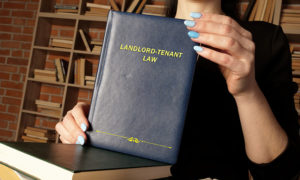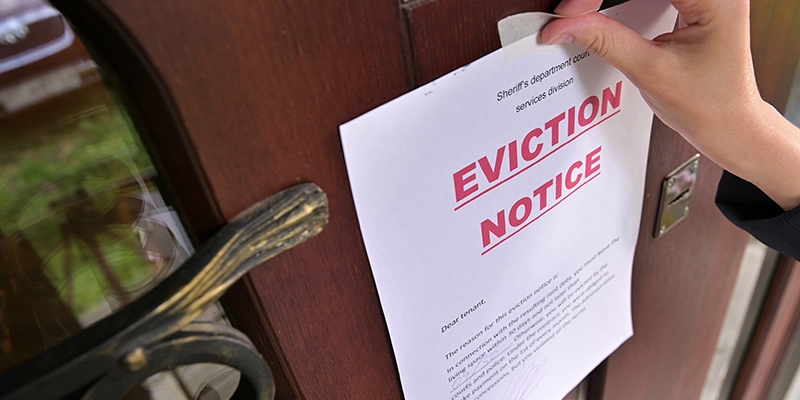While landlords can hope for model tenants who do no wrong, the unfortunate truth is that bad tenants do exist. In certain situations, you have no other option but to turn to eviction. Here is your guide on how to evict a tenant the right way.
How to Evict a Tenant in Five Easy Steps
When you run into a problem with your tenant, you would ideally work it out and come to a solution by communicating with them. Sometimes, though, tenants just won’t respond to a congenial approach. In that case, you may have no choice but to initiate eviction proceedings.
If you want to know how to evict a tenant quickly and legally, follow the steps below.
Step One: Know Your Eviction Laws
 The first thing you need to do is to familiarize yourself with the eviction laws in your area. The law can vary from state to state and even city to city. As such, there is no blanket solution that will universally apply to landlords across the country.
The first thing you need to do is to familiarize yourself with the eviction laws in your area. The law can vary from state to state and even city to city. As such, there is no blanket solution that will universally apply to landlords across the country.
Still, it is imperative that you know how the eviction laws work in your locale. You should also take the law into account when creating your lease agreement. Because the law can be difficult to navigate, it is a good idea to hire an attorney to help you with your eviction proceedings.
Step Two: Identify Your Cause
When can a landlord evict a tenant? This is a question that many landlords ask. Is it acceptable to evict a tenant without cause? Can I evict a tenant who threatens me? Let’s examine the possible causes for eviction.
Generally, here are the most common reasons to evict a tenant:
- Nonpayment of rent
- Violation of lease terms and conditions
- Damage to the property
- Engaging in illicit activities
- Harassment (feeling threatened or unsafe)
- Lease expiry
Remember that you need evidence to support your cause of eviction. Thus, it is important to document everything, including all communications between you and your tenant.
Step Three: Send a Notice to Terminate
Now that you have identified a valid cause for eviction, it is time to send a notice of termination. While notices can change in format, they should generally include the date by which your tenant must move out and any monetary amounts the tenant owes. You will also need to send this notice via certified mail so that you have proof that the tenant has received it.
Additionally, you will need to check your eviction laws to see how many days your tenant has to remedy the problem before you file the eviction with a court. For instance, in California, the law requires that you provide a three-day notice to pay rent prior to filing the eviction case.
If you want to terminate a tenancy, there are three types of notices you can use:
- Pay or Quit. This is the one you use for nonpayment of rent. In most states, tenants have 3 to 5 days to pay their rent or move out.
- Cure or Quit. This is the one you use if a tenant has violated a term of your lease (for example: bringing a pet when it is not allowed on the property). If the tenant fails to “cure” or fix the problem, an eviction lawsuit will follow.
- Unconditional Quit. This notice gives the tenant no chance to remedy the issue and, instead, goes straight to eviction. Not all states allow landlords to use this notice immediately, while others give certain conditions wherein the use of this notice is acceptable. A common example would be if the tenant has engaged in illegal acts such as dealing drugs on the premises.
Step Four: File the Eviction
Now comes the time to file the eviction. You will usually need to go to your local courthouse to file your suit. There, you will need to pay a fee before obtaining a hearing date. The clerk may also ask you to show proof that your tenant has received a notice of termination and that you followed eviction laws on time provisions. The court will then send your tenant a summons to attend the hearing.
Step Five: Attend the Court Hearing
Lastly, you will need to prepare for and attend the court hearing. This is when you will have to show evidence supporting your eviction claim. Remember to bring the following documents to your court hearing:
- The original copy of your signed lease agreement
- All payment records
- Written records of communication between you and your tenant
- Any bounced checks or payments
- A copy of the written eviction notice you sent to your tenant
- Proof that your tenant received the eviction notice at the appropriate time (usually a receipt from USPS with the tenant’s signature)
If the court rules in your favor, the judge will then give your tenant a specified amount of time to move out of the premises. This depends on local laws, though it usually falls between 48 hours to a week.
Sometimes, stubborn or resentful tenants will refuse to leave even after a court has ordered the eviction. In that case, you should not take matters into your own hands. Do not change the locks or remove your tenant’s belongings from the premises. The legal way is to ask local authorities for help. They will be the ones to escort the tenant from the premises and remove their belongings.
Collecting Unpaid Rent After Eviction
Sometimes, you will have a tenant with unpaid rent even after you have evicted them. If you want to collect that sum, you will need to go through small claims court. As with your eviction proceedings, it is best to hire a lawyer to prepare your small claims lawsuit. If you win the case, a judge may grant you compensation by ordering the tenant’s employer to garnish wages to pay the outstanding rent.
How Long Does It Take to Evict a Tenant?
Not all states have the same eviction procedures. Thus, the length of time it will take to evict your tenant will depend on where the property is located. In states with the fastest eviction proceedings, it can take as little as two weeks. In states with longer eviction proceedings, though, it can take as long as three months or more.
How to Evict a Tenant Without a Lease
 Is it possible to evict a tenant even if neither of you signed a lease agreement? The short answer is yes.
Is it possible to evict a tenant even if neither of you signed a lease agreement? The short answer is yes.
In most states, it is understood that you and your tenant entered an oral agreement. You can then treat this as a month-to-month lease, where the eviction process stays relatively the same. The only difference, though, is that you can terminate the lease at the end of any month even without a cause. But, you will still need to provide your tenant with a notice of termination.
To avoid complications, it is best to have a written and signed lease agreement when you allow anyone to stay in a property you own. This applies even to friends or relatives.
How Much Does It Cost to Evict a Tenant?
There are a handful of fees involved when you decide to evict a tenant. Between court fees, attorney fees, and sheriff costs, evicting someone does not come cheap. You will also need to factor in the cost of unpaid rent, the cost of repairs, and miscellaneous fees. All in all, you should expect to pay somewhere between $4,000 to $7,000.
COVID-19 Pandemic: Can I Evict a Tenant Now?
The COVID-19 pandemic prompted many governments (including federal and state governments) to put a hold on evicting tenants. As restrictions start to relax with the introduction of vaccines, there is no longer a CDC ban on evictions. But, the orders can still vary from state to state, even city to city. Therefore, it is best to check your local laws first or consult an attorney before commencing eviction proceedings.
A Helping Hand
Not many landlords know how to evict a tenant the legal way. Hopefully, through this guide, you now know the proper procedures for evictions and what requirements you must follow. Even with this handy guide, though, some landlords simply have no time or interest in managing their rental properties.
This is where Rental Choice comes in. Start looking for a property management company today using our online directory. With professional help, landlords will no longer need to worry about their duties, including evictions.
RELATED ARTICLES:
- What Is An Illegal Eviction? And What Can Tenants Do About It?
- Late Rent: Creating Late Rent Notices And Assessing Fees
- Avoiding Bad Tenants At All Cost




 Company
Company